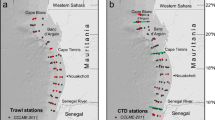Abstract
The diel distribution of epipelagic siphonophores at a station off northern Namibia (18°00′ S 10°30′ E) was studied. This area is characterized by the mixing of surface waters of the Angola Current with the waters of the northernmost Benguela region. During the sampling period, the continuous flow of the Angola Current gave rise to a marked thermocline at ca 30 m depth. In order to study the diel vertical distribution patterns of epipelagic species under these hydrographic conditions, narrow depth horizons in the top 200 m of the water column were sampled repeatedly over a 48 h period. Thirty-four species were collected. Sphaeronectes gracilis and Chelophyes appendiculata predominated. Increasing numbers of species and individuals were observed on the second day of sampling, particularly in the layers above the thermocline. Only a few species showed an upward nocturnal migration that crossed the boundary between 2 water masses. The differences in the depth distributions of the various species were related to 3 distinct phenomena: the existence of 2 separate siphonophore populations associated with each of the 2 water masses; vertical migration by the most abundant species, which were able to cross the thermocline; and differences in patch size for the most epipelagic species.
Similar content being viewed by others
References
Alvariño, A., 1971. Siphonophores of the Pacific with a review of the world distribution. Bull. Scripps Instn Oceanogr. tech. Ser. 16: 1–432.
Biggs, D. C., 1976. Nutritional ecology of Agalma okeni (Siphonophora: Physonectae). In G.O. Mackie (ed.), Coelenterate Ecology and Behavior. Plenum Press, N.Y.: 201–210.
Boyd, A. J., J. Salat & M. Masó, 1987. The seasonal intrusion of relatively saline water on the shelf off northern and central Namibia. In A. I. L. Payne, J. A. Gulland & K. H. Brink (eds), The Benguela and comparable ecosystems. S. Aft. J. mar. Sci. 5: 107–120.
Casanova, J. P., 1980. Campagnes du ‘Meteor’ dans l'Atlantique NE. Siphonophores, Méduses et Thécosomes. Distribution verticale et comparaisons faunistiques avec la Méditerranée. Meteor ForschErgebn. (Reihe D) 32: 15–32.
Mackie, G. O., P. R. Pugh & J. E. Purcell, 1987. Siphonophore Biology. Adv. mar. Biol. 24: 97–262.
Pugh, P. R., 1977. Some observations on the vertical migration and geographical distribution of siphonophores in the warm waters of the North Atlantic Ocean. National Inst. of Oceanogr., Goa, India: Proc. Symp. Warm Waters Zooplankton: 362–378.
Pugh, P. R., 1984. The diel migrations and distribution within a mesopelagic community in the North East Atlantic. 7. Siphonophores. Prog. Oceanogr. 13: 461–489.
Purcell, J. E., 1980. Influence of siphonophore behavior upon their natural diets: evidence for aggressive mimicry. Science, N.Y. 209: 1045–1047.
Shannon, L. V., 1985. The Benguela Ecosystem. Part. I. Evolution of the Benguela, physical features and processes. Oceanography mar. Biol. A. Rev. 23: 105–182.
Totton, A. K., 1965. A synopsis of the Siphonophora. Brit. Mus. (Nat. Hist.), London, 230 pp.
Author information
Authors and Affiliations
Rights and permissions
About this article
Cite this article
Pagès, F., Gili, J.M. Vertical distribution of epipelagic siphonophores at the confluence between Benguela waters and the Angola Current over 48 hours. Hydrobiologia 216, 355–362 (1991). https://doi.org/10.1007/BF00026486
Issue Date:
DOI: https://doi.org/10.1007/BF00026486




